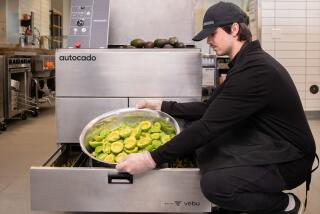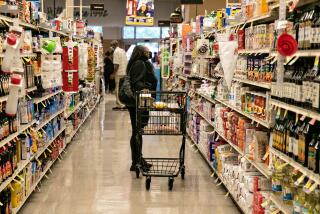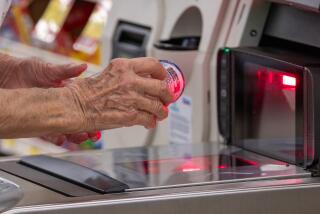Self-Scan Checkouts Register With Grocers
You can buy gas, get cash from your bank account and pick up an airline boarding pass without ever coming into contact with another human being.
Now you can avoid people when you pay at the grocery store. Supermarkets are joining the self-serve movement, adding lanes where shoppers can scan and sack their purchases, no checker required.
That has union officials worried. Although the dispute in the California supermarket strike that has idled 70,000 workers is centered on pay and benefits, not scanners, unions are concerned that the machines eventually will wipe out some cashier jobs that can pay up to about $17 an hour.
“It’s a threat,” said Greg Denier, spokesman for the United Food and Commercial Workers union. “In the long run, there would be fewer and fewer jobs, particularly at the cashier level, which is one of the best-paying jobs in the store.”
In the last two years, about a third of all grocery retailers have installed or tested self-scan checkouts.
A bank of four automated lanes and a monitoring station can cost upwards of $80,000 but will pay for itself in 12 to 18 months, said Mike Webster, vice president and general manager of NCR Corp.’s self-checkout division.
By 2005, annual sales of self-checkout systems are expected to more than triple to $1 billion.
Larry Johnston, chief executive of Albertsons Inc., says they ultimately will be as ubiquitous as ATMs. Albertsons has purchased 4,000 of the machines to install next year, almost quadrupling the number now in its stores.
Albertsons and other grocery chains contend that they’re not trying to replace workers with machines but are aiming to improve customer service by moving clerks to bakery, deli, floral and meat counters where they can develop relationships with customers and have more influence on spending.
Kroger Co. was among the first to adopt the technology and has self-checkout lanes in about 300 of its 2,300 stores, including at about two dozen Ralphs and Food 4 Less stores in California.
But “you don’t want to go through there with $100 worth of groceries,” said Esper Zamora, assistant store manager of a Food 4 Less in Rancho Cucamonga, which has four self-scan checkouts.
They work best, she said, when customers are just purchasing a few items.
To use automated lanes, people follow instructions on a video screen. They scan individual items, including stickers on produce, before weighing and bagging their groceries. They can pay by debit or credit cards or by feeding cash into the machines.
If there’s a problem, or a customer needs to show identification to purchase liquor, a cashier monitoring each bank of four machines comes over to assist.
To prevent theft, there is a camera system employees monitor and a scale that matches the weight of goods being carted off with the details read by the scanner.
A Ralphs spokesman said the theft rate on self-checkout machines was so tiny it had not been a problem.
Many customers use the machines because they think they can get out of the store quicker, Zamora said. “Now we get lines there, just like we do at other check stands.”
Ultimately, the machines will provide big savings, analysts say, saving stores 80 to 120 labor hours per week.
Retailers such as Kmart Corp. and Home Depot Inc. have rolled out self-checkouts in many of their stores in the last few years. Some supermarkets, however, are being cautious.
“The technology has clearly gotten better,” said Brian Dowling, a spokesman for Safeway Inc., which is trying the machines in three of its approximately 1,700 stores.
But “we have not yet come to any conclusion about whether we should take it out of the test stage,” he said.
Ultimately, analysts say, rising labor costs will convince grocers. Nationwide, a person has to spend $15 on a transaction “for the retailer to break even” when a cashier is involved, said Greg Buzek of IHL Consulting Group. In California, where labor is more expensive, that break-even point is closer to $25 per transaction, he said. He hasn’t calculated the scanner break-even point.
Buzek said California had fewer self-scan machines than almost anywhere in the country, despite its higher labor costs and its large population of tech-savvy residents.
In his hometown of Franklin, Tenn., only one supermarket chain doesn’t have self-checkout lanes.
In California, he said, “I guess there’s a different level of expectations” about customer service.
More to Read
Inside the business of entertainment
The Wide Shot brings you news, analysis and insights on everything from streaming wars to production — and what it all means for the future.
You may occasionally receive promotional content from the Los Angeles Times.










